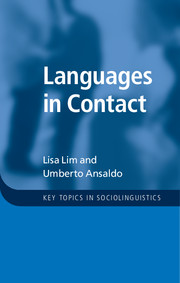Book contents
- Frontmatter
- Contents
- List of figures
- List of tables
- Preface
- Acknowledgements
- List of abbreviations
- 1 Perspectives on contact
- 2 Contact and code choice
- 3 Contact and creole formation
- 4 Contact and language evolution
- 5 Contact and ecology
- 6 Contact and shift
- 7 Contact and globalisation
- 8 Reflections and future directions
- References
- Index
4 - Contact and language evolution
Published online by Cambridge University Press: 05 November 2015
- Frontmatter
- Contents
- List of figures
- List of tables
- Preface
- Acknowledgements
- List of abbreviations
- 1 Perspectives on contact
- 2 Contact and code choice
- 3 Contact and creole formation
- 4 Contact and language evolution
- 5 Contact and ecology
- 6 Contact and shift
- 7 Contact and globalisation
- 8 Reflections and future directions
- References
- Index
Summary
INTRODUCTION
When we move beyond creole genesis and look at the ways in which languages change over time, we realise we are actually contemplating a much bigger question. With our increasing understanding of linguistic diversity, one of the most challenging questions faced by modern linguistics is to explain how and why human societies have come to be characterised by such different linguistic systems over time. Does language contact play any role in the evolution of diversity? In this chapter we present two approaches that tackle this question.
THE CREOLE PROTOTYPE
Continuing on the discussion in Chapter 3, this chapter presents the most recent developments in the field of creole theory and contact language formation.
Probably the most debated approach to creole genesis since Bickerton, John McWhorter's (1998) ‘Creole Prototype’ (CP) develops a view of creole languages as a synchronically definable typological class, with a unique set of structural criteria. The data sample on which the CP is based includes eight languages which constitute examples of ‘typical’ creoles – that is, natively spoken languages that were allegedly created via rapid adoption as a lingua franca by slave populations five hundred years ago or less. These are Ndjuka English Creole, Tok Pisin English Creole, Saramaccan English Creole, Haitian French Creole, St Lucian French Creole, Mauritian French Creole, Fa D'Ambu and Negerhollands Dutch Creole. The three structural features shared uniquely by creoles postulated by McWhorter (1998, 2000, 2011) are the following.
i. Minimal use of inflectional affixation. This is defined as the most salient feature of typical creole languages which, McWhorter claims, rarely have more than one or two inflectional affixes. For example, while Tok Pisin has two – the transitive marker -im and the marker -pela for adjectivehood (Mühlhäusler 1985) – Fa D'Ambu has one, which is marginally productive (Post 1994), and Negerhollands has one inflection – sini for plurality, which is optional. In addition, McWhorter claims that the inflectional affixes are always monomorphemic, and paradigms of allomorphs are not found in creoles. This he explains as the result of the stripping down of a system for its optimal learnability and processability.
[…]
- Type
- Chapter
- Information
- Languages in Contact , pp. 80 - 101Publisher: Cambridge University PressPrint publication year: 2015



